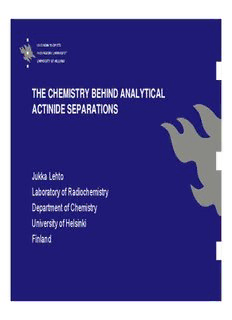
the chemistry behind analytical actinide separations - NKS - Nordic PDF
Preview the chemistry behind analytical actinide separations - NKS - Nordic
THE CHEMISTRY BEHIND ANALYTICAL ACTINIDE SEPARATIONS Jukka Lehto Laboratory of Radiochemistry Department of Chemistry University of Helsinki Finland Laboratory of Radiochemistry 30 persons including 13 doctoral students Comprehensive master’s program in radiochemistry Research areas: Migration of radionuclides in geosphere related to final disposal of spent nuclear fuel Selective separation of radionuclides from nuclear waste effluents Radiopharmaceutical chemistry Environmental radioactivy Actinides MOST RELEVANT ACTINIDES IN THE ENVIRONMENT AND/OR NUCLEAR WASTE Thorium (228,230,232Th) – natural Uranium (234,235,238U) – natural Neptunium (237Np) – artificial Plutonium (238,239,240,241Pu) – artificial Americium (241Am) - artificial Activities and concentration of actinides in 10 cm surface soil in Finland Nuclide Bq/kg g/kg mol/kg 210Po 30 2 × 10-13 9 × 10-16 226Ra 20 5 × 10-10 2 × 10-12 228Th 20 7 × 10-13 3 × 10-15 230Th 20 3 × 10-8 1 × 10-10 232Th 20 5 × 10-3 2 × 10-5 234U 20 9 × 10-8 4 × 10-10 238U 20 2 × 10-3 7 × 10-6 237Np 0.002 7 × 10-11 3 × 10-13 238Pu 0.02 2 × 10-14 1 × 10-16 239,240Pu 0.5 2 × 10-10 8 × 10-13 241Am 0.2 2 × 10-12 6 × 10-15 MEASUREMENT OF ACTINIDE CONCENTRATIONS AND ISOTOPIC COMPOSITION - 1 Alpha spectrometry Interferences from each other and from 210Po and 226Ra MEASUREMENT OF ACTINIDE CONCENTRATIONS AND ISOTOPIC COMPOSITION - 2 Mass spectrometry Interferences: - From isobars (238Pu cannot be measured due to presence of 238U) - From tailings (239Pu cannot be measured if large excess of 238U is present) - From polyatomic ions (238UH interferes with 239Pu measurement RADIOCHEMICAL SEPARATIONS ARE NEEDED Precipitation Ion exchange Solvent extraction Extraction chromatography Mass vs. activity – effect on separation activity (Bq) mass (g) 238U 20 2 × 10-3 239Pu 0.5 2 × 10-10 Excess of U 40-times 1010-times If uranium is removed by a factor of 10000, its activity is only 0.4% of that of plutonium uranium does not intefer with plutonium measurement by alpha spectrometry If plutonium is to be measured ICP-MS, there is still 106-times excess of plutonium, which does not allow Pu measurement MAIN CHEMICAL PARAMETERS BEHIND ANALYTICAL SEPARATIONS OF ACTINIDES Complex formation with Cl- and NO - 3 General trend: the higher the charge density of a cation the stronger the complex (coulombic interaction) Charge density of a cation increases with: Smaller size Higher charge
Description: